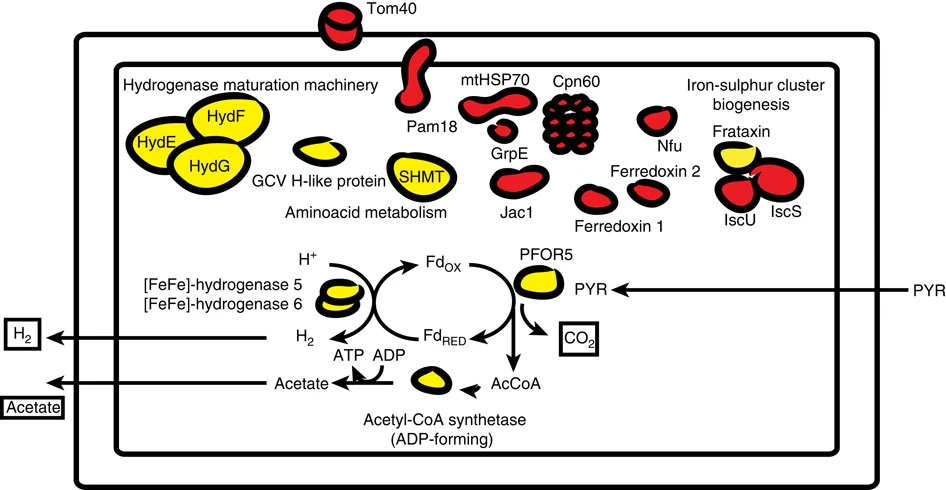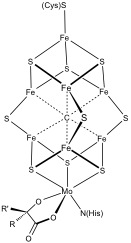|
Mitosome
A mitosome (also called a ''crypton'' in early literature) is a mitochondrion-related organelle (MRO) found in a variety of parasitic unicellular eukaryotes, such as members of the supergroup Excavata. The mitosome was first discovered in 1999 in ''Entamoeba histolytica,'' an intestinal parasite of humans, and mitosomes have also been identified in several species of Microsporidia and in '' Giardia intestinalis''. The mitosome has been detected only in anaerobic or microaerophilic eukaryotes which do not have fully developed mitochondria, and hence do not have the capability of gaining energy from mitochondrial oxidative phosphorylation. The functions of mitosomes, while varied, have not yet been well characterized, but they may be associated with sulfate metabolism and biosynthesis of phospholipids and Fe–S clusters. Mitosomes, like other MROs, likely evolved from mitochondria, based on similarities in structure, function, and biochemical signaling pathways, and may have conve ... [...More Info...] [...Related Items...] OR: [Wikipedia] [Google] [Baidu] |
Hydrogenosome
A hydrogenosome is a membrane-enclosed organelle found in some Anaerobic organism, anaerobic Ciliate, ciliates, Flagellate, flagellates, Fungus, fungi, and three species of Loricifera, loriciferans. Hydrogenosomes are highly variable organelles that have presumably evolved from protoMitochondrion, mitochondria to produce molecular hydrogen and Adenosine triphosphate, ATP in anaerobic conditions. Hydrogenosomes were discovered in 1973 by D. G. Lindmark and M. Müller. Because hydrogenosomes hold evolutionary lineage significance for organisms living in anaerobic or oxygen-stressed environments, many research institutions have since documented their findings on how the organelle differs in various sources. History Hydrogenosomes were isolated, purified, biochemically characterized and named in the early 1970s by Lindmark and Müller at Rockefeller University. In addition to this seminal study on hydrogenosomes, they also demonstrated for the first time the presence of Pyruvate:fe ... [...More Info...] [...Related Items...] OR: [Wikipedia] [Google] [Baidu] |
Mastigamoeba Balamuthi
''Mastigamoeba'' is a genus of pelobionts, and treated by some as members of the Archamoebae group of protists. ''Mastigamoeba ''are characterized as anaerobic, amitochondriate organisms that are polymorphic. Their dominant life cycle stage is as an amoeboid flagellate. Species are typically free living, though endobiotic species have been described. The genus is relatively understudied, and under contention regarding the composition of the genus. While dozens of species have been described (some in other genera such as ''Phreatamoeba'', ''Dinamoeba'', and ''Mastigina''), the well described species are ''Mastigamoeba aspera'' Schulze, 1875; ''Mastigamoeba simplex'' Kent, 1880; ''Mastigamoeba chlamys'' Frenzel, 1897 Lemmermann, 1914; ''Mastigamoeba viridis'' Prowazek, 1900; ''Mastigamoeba trichophora'' Lauterborn, 1901; ''Mastigamoeba balamuthi'' (Chàvez et al., 1986) Simpson et al., 1997; ''Mastigamoeba schizophrenia'' Simpson et al., 1997; and ''Mastigamoeba punctachora'' Ber ... [...More Info...] [...Related Items...] OR: [Wikipedia] [Google] [Baidu] |
Iron–sulfur Protein
Iron–sulfur proteins are proteins characterized by the presence of iron–sulfur clusters containing sulfide-linked di-, tri-, and tetrairon centers in variable oxidation states. Iron–sulfur clusters are found in a variety of metalloproteins, such as the ferredoxins, as well as NADH dehydrogenase, hydrogenases, coenzyme Q – cytochrome c reductase, succinate – coenzyme Q reductase and nitrogenase. Iron–sulfur clusters are best known for their role in the oxidation-reduction reactions of electron transport in mitochondria and chloroplasts. Both Complex I and Complex II of oxidative phosphorylation have multiple Fe–S clusters. They have many other functions including catalysis as illustrated by aconitase, generation of radicals as illustrated by SAM-dependent enzymes, and as sulfur donors in the biosynthesis of lipoic acid and biotin. Additionally, some Fe–S proteins regulate gene expression. Fe–S proteins are vulnerable to attack by biogenic nitric oxide, formin ... [...More Info...] [...Related Items...] OR: [Wikipedia] [Google] [Baidu] |
Giardia Intestinalis
''Giardia duodenalis'', also known as ''Giardia intestinalis'' and ''Giardia lamblia'', is a flagellated parasitic protozoan microorganism of the genus ''Giardia'' that colonizes the small intestine, causing a diarrheal condition known as giardiasis. The parasite attaches to the intestinal epithelium by a ventral disc (''syn''. adhesive disc or sucker), and reproduces via binary fission. ''G. duodenalis'' is a non-invasive parasite, that does not spread to other parts of the gastrointestinal tract, but remains confined to the lumen of the small intestine. The parasite exists in two forms; trophozoites and cysts. The microorganism can undergo encystation, transforming into a dormant cyst that enables it to survive outside of its host. ''Giardia'' trophozoites are anaerobic, and absorb their nutrients from the intestinal lumen. If the organism is stained, its characteristic pattern resembles the familiar " smiley face" symbol. Chief pathways of human infection include ingestio ... [...More Info...] [...Related Items...] OR: [Wikipedia] [Google] [Baidu] |
Trophozoite
A trophozoite (G. ''trope'', nourishment + ''zoon'', animal) is the activated, feeding stage in the life cycle of certain protozoa such as malaria-causing ''Plasmodium falciparum'' and those of the ''Giardia'' group. The complementary form of the trophozoite state is the thick-walled microbial cyst, cyst form. They are often different from the cyst stage, which is a protective, dormant form of the protozoa. Trophozoites are often found in the host's body fluids and tissues and in many cases, they are the form of the protozoan that causes disease in the host. In the protozoan, ''Entamoeba histolytica'' it invades the intestinal mucosa of its host, causing dysentery, which aid in the trophozoites traveling to the liver and leading to the production of hepatic abscesses. Life cycle stages ''Plasmodium falciparium'' The causative organism of malaria is a protozoan, ''Plasmodium falciparium'', that is carried by the female Anopheles mosquito, ''Anopheles'' mosquito. Malaria is reco ... [...More Info...] [...Related Items...] OR: [Wikipedia] [Google] [Baidu] |
Sulfate
The sulfate or sulphate ion is a polyatomic anion with the empirical formula . Salts, acid derivatives, and peroxides of sulfate are widely used in industry. Sulfates occur widely in everyday life. Sulfates are salts of sulfuric acid and many are prepared from that acid. Spelling "Sulfate" is the spelling recommended by IUPAC, but "sulphate" was traditionally used in British English. Structure The sulfate anion consists of a central sulfur atom surrounded by four equivalent oxygen atoms in a tetrahedral arrangement. The symmetry of the isolated anion is the same as that of methane. The sulfur atom is in the +6 oxidation state while the four oxygen atoms are each in the −2 state. The sulfate ion carries an overall charge of −2 and it is the conjugate base of the bisulfate (or hydrogensulfate) ion, , which is in turn the conjugate base of , sulfuric acid. Organic sulfate esters, such as dimethyl sulfate, are covalent compounds and esters of sulfuric acid. The tetrahedral ... [...More Info...] [...Related Items...] OR: [Wikipedia] [Google] [Baidu] |
Adenosine Triphosphate
Adenosine triphosphate (ATP) is a nucleoside triphosphate that provides energy to drive and support many processes in living cell (biology), cells, such as muscle contraction, nerve impulse propagation, and chemical synthesis. Found in all known forms of life, it is often referred to as the "molecular unit of currency" for intracellular energy transfer. When consumed in a Metabolism, metabolic process, ATP converts either to adenosine diphosphate (ADP) or to adenosine monophosphate (AMP). Other processes regenerate ATP. It is also a Precursor (chemistry), precursor to DNA and RNA, and is used as a coenzyme. An average adult human processes around 50 kilograms (about 100 mole (unit), moles) daily. From the perspective of biochemistry, ATP is classified as a nucleoside triphosphate, which indicates that it consists of three components: a nitrogenous base (adenine), the sugar ribose, and the Polyphosphate, triphosphate. Structure ATP consists of three parts: a sugar, an amine base ... [...More Info...] [...Related Items...] OR: [Wikipedia] [Google] [Baidu] |
Hsp70
The 70 kilodalton heat shock proteins (Hsp70s or DnaK) are a family of conserved ubiquitously expressed heat shock proteins. Proteins with similar structure exist in virtually all living organisms and play crucial roles in the development of cancer, neurodegeneration, apoptosis, regulating sleep, and much more. Intracellularly localized Hsp70s are an important part of the cell's machinery for protein folding, performing chaperoning functions, and helping to protect cells from the adverse effects of physiological stresses. Additionally, membrane-bound Hsp70s have been identified as a potential target for cancer therapies and their extracellularly localized counterparts have been identified as having both membrane-bound and membrane-free structures. There is lot of potential in the Hsp70 protein as a key therapeutic target for developing new drugs for the treatment of sleep disorders, cancer, neurodegeneration, and other related pathological conditions. Discovery Members of the ... [...More Info...] [...Related Items...] OR: [Wikipedia] [Google] [Baidu] |
Isu1
Iron-sulfur cluster assembly enzyme ISCU, mitochondrial is a protein that in humans is encoded by the ''ISCU'' gene. It encodes an iron-sulfur (Fe-S) cluster scaffold protein involved in 2Fe-2S">2Fe-2S_cluster.html" ;"title="nowiki/>2Fe-2S cluster">2Fe-2Sand [4Fe-4S] cluster synthesis and maturation. A deficiency of ISCU is associated with a mitochondrial myopathy with lifelong exercise intolerance where only minor exertion causes tachycardia, shortness of breath, muscle weakness and myalgia. Updated 2011 Sep 1 Structure ''ISCU'' is located on the q arm of chromosome 12 in position 23.3 and has 8 exons. ISCU, the protein encoded by this gene, is a member of the NifU family. It is an iron-sulfur transferase that contains binding sites for 2Fe-2S">2Fe-2S_cluster.html" ;"title="nowiki/>2Fe-2S cluster">2Fe-2Sand [4Fe-4S] clusters. ISCU contains a transit peptide, 4 Beta sheet, beta strands, 4 alpha helixes, and 4 turns. Alternative splicing results in transcript variants encodi ... [...More Info...] [...Related Items...] OR: [Wikipedia] [Google] [Baidu] |
Cysteine Desulfurase
In enzymology, a cysteine desulfurase () is an enzyme that catalyzes the chemical reaction :L-cysteine + nzymecysteine \rightleftharpoons L-alanine + nzymeS-sulfanylcysteine Thus, the two substrates of this enzyme are L-cysteine and nzymecysteine], whereas its two product (chemistry), products are L-alanine and nzymeS-sulfanylcysteine. One group of authors has given it the acronym hapE, for hydrogen sulfide, alanine, and pyruvate producing enzyme. This enzyme belongs to the family of transferases, specifically the sulfurtransferases, which transfer sulfur-containing groups. The systematic name of this enzyme class is L-cysteine: nzyme cysteinesulfurtransferase. Other names in common use include IscS, NIFS, NifS, SufS, and cysteine desulfurylase. Function Bacteria contain cysteine desulfurases to form iron sulfur clusters in proteins. However recently it has been shown that the enzyme, which produces hydrogen sulfide from cysteine, is also a virulence factor, namely fo ... [...More Info...] [...Related Items...] OR: [Wikipedia] [Google] [Baidu] |
Frataxin
Frataxin is a protein that in humans is encoded by the ''FXN'' gene. It is located in the mitochondrion and Frataxin mRNA is mostly expressed in tissues with a high metabolic rate. The function of frataxin is not clear but it is involved in assembly of iron-sulfur clusters. It has been proposed to act as either an iron chaperone or an iron storage protein. Reduced expression of frataxin is the cause of Friedreich's ataxia. Structure X-ray crystallography has shown that human frataxin consists of a β-sheet that supports a pair of parallel α-helices, forming a compact αβ sandwich. Frataxin homologues in other species are similar, sharing the same core structure. However, the frataxin tail sequences, extending from the end of one helix, diverge in sequence and differ in length. Human frataxin has a longer tail sequence than frataxin found in bacteria or yeast. It is hypothesized that the purpose of the tail is to stabilize the protein. Like most mitochondrial protei ... [...More Info...] [...Related Items...] OR: [Wikipedia] [Google] [Baidu] |
Iron–sulfur Cluster Biosynthesis
In biochemistry, the iron–sulfur cluster biosynthesis describes the components and processes involved in the biosynthesis of iron–sulfur proteins. The topic is of interest because these proteins are pervasive. The iron sulfur proteins contain iron–sulfur clusters, some with elaborate structures, that feature iron and sulfide centers. One broad biosynthetic task is producing sulfide (S2-), which requires various families of enzymes. Another broad task is affixing the sulfide to iron, which is achieved on scaffolds, which are nonfunctional. Finally these Fe-S cluster is transferred to a target protein, which then become functional. The formation of iron–sulfur clusters are produced by one of four pathways: *Nitrogen fixation (NIF) system, which is also found in bacteria that are not nitrogen-fixing. *Iron–sulfur cluster (ISC) system, in bacterial and mitochondria *Sulfur assimilation (SUF) system, in plastids and some bacteria In addition to those three systems, the so ... [...More Info...] [...Related Items...] OR: [Wikipedia] [Google] [Baidu] |



